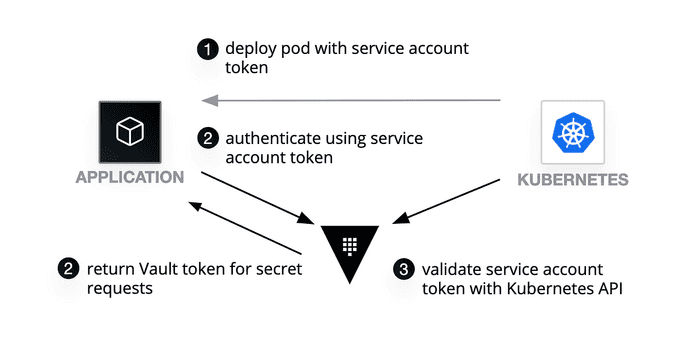
Securely Inject Secrets to Pods with the Vault Agent Injector
Content
A Must-Have Tool for Securing Your Kubernetes Secrets
⭐️ Introduction
In today's tech-driven world, keeping data secure is a big deal. Kubernetes helps manage software in containers, but it can have security limits, especially for sensitive info. To fix this, we can connect Kubernetes with Vault, a tool that stores secrets safely.
Vault Agent does the job here, so your apps don't need to know about Vault. But to make this work, you need to set up Vault Agent with your apps.
The Vault Helm chart makes it easy. It lets you run Vault and Vault Agent Sidecar Injector, which helps manage secrets for your apps.
This is great because:
- ✔️ Apps don't have to worry about Vault; secrets are stored in their container.
- ✔️ You don't have to change your existing setups; just add some annotations.
- ✔️ You can control who gets access to secrets using Kubernetes.
In this tutorial, we'll set up Vault and the injector service with the Vault Helm chart. Then, we'll deploy some apps to show how the injector service handles secrets.

📕 Prerequisites
Before you begin, make sure you have the following tools installed:
- 🐳 Docker
- ☸️ Kubernetes command-line interface (CLI)
- 🎛️ Helm CLI
- 🖥️ Minikube
🏞 Clone GitHub repositories
To get the web application and additional configuration, clone the seifrajhi/vault-k8s-sidecar-injector repository from GitHub using the following commands:
git clone https://github.com/seifrajhi/vault-k8s-sidecar-injector.gitAfter cloning, navigate to the cloned repository:
cd vault-k8s-sidecar-injectorThis will take you to the repository directory.
🐳 Preparing Kubernetes v1.26.3 on Docker 23.0.2 ...
🔗 Configuring bridge CNI (Container Networking Interface) ...
🔎 Verifying Kubernetes components...
▪ Using image gcr.io/k8s-minikube/storage-provisioner:v5
🌟 Enabled addons: storage-provisioner, default-storageclass
🏄 Done! kubectl is now configured to use "minikube" cluster and "default" namespace by defaultMinikube provides a visual representation of the status in a web-based dashboard. This interface displays the cluster activity in a visual interface that can assist in delving into the issues affecting it.
In another terminal, launch the minikube dashboard:
minikube dashboardThe default browser opens and displays the dashboard.

🏗 Deploy Vault inside the cluster
Deploying the Vault Helm chart is the preferred method for running Vault on Kubernetes. Helm, acting as a package manager, simplifies the installation and configuration of all essential components required for Vault's operation in various modes. Helm charts come equipped with templates that facilitate conditional and customizable execution. You can specify these parameters either through command-line inputs or by defining them in YAML files.
Add the HashiCorp Helm repository:
helm repo add hashicorp https://helm.releases.hashicorp.com"hashicorp" has been added to your repositoriesUpdate all the repositories to ensure helm is aware of the latest versions:
helm repo updateHang tight while we grab the latest from your chart repositories...
...Successfully got an update from the "hashicorp" chart repository
Update Complete. ⎈Happy Helming!⎈Install the latest version of the Vault server running in development mode:
helm install vault hashicorp/vault --set "server.dev.enabled=true"The Vault pod and Vault Agent Injector pod are deployed in the default namespace. Display all the pods in the default namespace:
kubectl get podsNAME READY STATUS RESTARTS AGE
vault-0 1/1 Running 0 2m
vault-agent-injector-4991fb98b5-tpgof 1/1 Running 0 2mThe vault-0 pod runs a Vault server in development mode. The vault-agent-injector pod performs the injection based on the annotations present or patched on a deployment.
Running a Vault server in development is automatically initialized and unsealed. This is ideal in a learning environment but NOT recommended for a production environment.
👮 Create Vault Secrets & Policy
To demonstrate the Vault Agent Injector functionality, we will create the following:
- A set of secrets using the Vault KV engine.
- A Vault policy to read the secrets.
- Enable Vault Kubernetes authentication.
- Create a Vault role to bind the Vault policy and Kubernetes service account (
vault-auth). - Create a
vault-authKubernetes service account to be used for Vault server authentication.
🗝️ Establishing a Secret in Vault
It's essential for the applications deployed in the next section to have Vault store a username and password at the designated location, namely internal/database/config. This process involves enabling a key-value secret engine and populating the specified path with the necessary username and password.
-
Exec into the Vault pod:
kubectl exec -it vault-0 -- /bin/shYour system prompt is replaced with a new prompt (
/ $). Commands issued at this prompt are executed on thevault-0container. -
Enable the Vault KV engine (key-value store) at the path
internal:vault secrets enable -path=internal kv-v2Success! Enabled the kv-v2 secrets engine at: internal/ -
Create a secret at the path
internal/database/configwith a username and password:vault kv put internal/database/config username="db-readonly-username" password="db-secret-password"Key Value --- ----- created_time 2023-09-04T09:55:01.111711644Z deletion_time n/a destroyed false version 1 -
Verify that the secret is defined at the path
internal/database/config:vault kv get internal/database/config====== Metadata ====== Key Value --- ----- created_time 2023-09-04T09:55:01.111711644Z deletion_time n/a destroyed false version 1 ====== Data ====== Key Value --- ----- password db-secret-password username db-readonly-username
🔑 Enable Kubernetes Authentication
Vault provides a Kubernetes authentication method that enables clients to authenticate with a Kubernetes Service Account Token. This token is provided to each pod when it is created.
-
Exec into the Vault pod:
kubectl exec -it vault-0 -- /bin/sh -
Enable Kubernetes authentication:
vault auth enable kubernetesSuccess! Enabled kubernetes auth method at: kubernetes/ -
Configure the Kubernetes authentication method to use the location of the Kubernetes API:
vault write auth/kubernetes/config \ token_reviewer_jwt="$(cat /var/run/secrets/kubernetes.io/serviceaccount/token)" \ kubernetes_host="https://$KUBERNETES_PORT_443_TCP_ADDR:443" \ kubernetes_ca_cert=@/var/run/secrets/kubernetes.io/serviceaccount/ca.crt -
Write out the policy named
internal-appthat enables the read capability for secrets at pathinternal/data/database/config:vault policy write internal-app - <<EOF path "internal/data/database/config" { capabilities = ["read"] } EOF -
Create a Vault role named
internal-appthat bindsinternal-appandinternal-appKubernetes service account:vault write auth/kubernetes/role/internal-app \ bound_service_account_names=internal-app \ bound_service_account_namespaces=default \ policies=internal-app \ ttl=24h
🆔 Define a Kubernetes Service Account
The Vault Kubernetes authentication role defined a Kubernetes service account named internal-app. A service account provides an identity for processes that run in a Pod. With this identity, we will be able to run the application within the cluster.
-
Create a Kubernetes service account named
internal-appin the default namespace:kubectl create sa internal-app -
Apply the deployment defined in
deployment-orgchart.yaml:kubectl apply -f deployment-orgchart.yamldeployment.apps/orgchart created -
Get all the pods in the default namespace and note down the name of the pod with a name prefixed with
orgchart-:kubectl get podsNAME READY STATUS RESTARTS AGE orgchart-69697d9598-l878s 1/1 Running 0 30s vault-0 1/1 Running 0 45m vault-agent-injector-4991fb98b5-tpgof 1/1 Running 0 45m -
Verify that no secrets are written to the
orgchartcontainer in theorgchartpod:kubectl exec $(kubectl get pod -l app=orgchart -o jsonpath="{.items[0].metadata.name}") \ --container orgchart -- ls /vault/secretsls: /vault/secrets: No such file or directory command terminated with exit code 1
🔐 Injecting Secrets into Pods
In this process, the deployment operates the pod using the internal-app Kubernetes service account within the default namespace. The Vault Agent Injector exclusively makes adjustments to a deployment when specific annotations are present. If an existing deployment lacks these annotations, its definition can be patched to include them.
spec:
template:
metadata:
annotations:
vault.hashicorp.com/agent-inject: 'true'
vault.hashicorp.com/role: 'internal-app'
vault.hashicorp.com/agent-inject-secret-database-config.txt: 'internal/data/database/config'These annotations define a partial structure of the deployment schema and are prefixed with vault.hashicorp.com.
- agent-inject enables the Vault Agent Injector service.
- role is the Vault Kubernetes authentication role.
- agent-inject-secret-FILEPATH prefixes the path of the file,
database-config.txtwritten to the/vault/secretsdirectory. The value is the path to the secret defined in Vault.
-
Patch the
orgchartdeployment defined inpatch-inject-secrets.yaml:kubectl patch deployment orgchart --patch "$(cat patch-inject-secrets.yaml)"deployment.apps/orgchart patchedA new
orgchartpod starts alongside the existing pod. When it is ready, the original terminates and removes itself from the list of active pods. -
Wait until the re-deployed
orgchartpod reports that it is Running and ready (2/2).This new pod now launches two containers: the application container, named
orgchart, and the Vault Agent container, namedvault-agent. -
Display the logs of the
vault-agentcontainer in the neworgchartpod:kubectl logs $(kubectl get pod -l app=orgchart -o jsonpath="{.items[0].metadata.name}") \ --container vault-agentVault Agent manages the token lifecycle and the secret retrieval. The secret is rendered in the
orgchartcontainer at the path/vault/secrets/database-config.txt. -
Display the secret written to the
orgchartcontainer:kubectl exec $(kubectl get pod -l app=orgchart -o jsonpath="{.items[0].metadata.name}") \ --container orgchart -- cat /vault/secrets/database-config.txt
🔒 Vault Agent Template Example
You can use Vault templates to render secrets in required formats. In this example, we will see how to use templates in deployment annotation.
To apply this template, a new set of annotations need to be applied.
spec:
template:
metadata:
annotations:
vault.hashicorp.com/agent-inject: 'true'
vault.hashicorp.com/agent-inject-status: 'update'
vault.hashicorp.com/role: 'internal-app'
vault.hashicorp.com/agent-inject-secret-database-config.txt: 'internal/data/database/config'
vault.hashicorp.com/agent-inject-template-database-config.txt: |
{{- with secret "internal/data/database/config" -}}
postgresql://{{ .Data.data.username }}:{{ .Data.data.password }}@postgres:5432/wizard
{{- end -}}This patch contains two new annotations:
- agent-inject-status set to
updateinforms the injector to reinject these values. - agent-inject-template-FILEPATH prefixes the file path. The value defines the Vault Agent template to apply to the secret's data.
The template formats the username and password as a PostgreSQL connection string.
-
Apply the updated annotations:
kubectl patch deployment orgchart --patch "$(cat patch-inject-secrets-as-template.yaml)"deployment.apps/exampleapp patched -
Wait until the re-deployed
orgchartpod reports that it is Running and ready (2/2). -
Finally, display the secret written to the
orgchartcontainer in theorgchartpod:kubectl exec $(kubectl get pod -l app=orgchart -o jsonpath="{.items[0].metadata.name}") \ -c orgchart -- cat /vault/secrets/database-config.txtThe secrets are rendered in a PostgreSQL connection string present on the container:
postgresql://db-readonly-user:db-secret-password@postgres:5432/wizard
🔚 Conclusion
Incorporating Kubernetes alongside Vault for secret management, the use of a Vault injector offers a seamless approach to integrating secrets into pods. This approach eliminates the need for applications to directly interact with the secret management system; they simply retrieve secrets from a predefined file path.
Furthermore, it's vital to ensure high availability of the production Vault server. An unavailable Vault server could potentially lead to application disruptions, particularly during activities such as pod restarts or scaling operations.
Until next time, つづく 🎉
💡 Thank you for Reading !! 🙌🏻😁📃, see you in the next blog.🤘 Until next time 🎉
🚀 Thank you for sticking up till the end. If you have any questions/feedback regarding this blog feel free to connect with me:
♻️ LinkedIn: https://www.linkedin.com/in/rajhi-saif/
♻️ X/Twitter: https://x.com/rajhisaifeddine
The end ✌🏻
🔰 Keep Learning !! Keep Sharing !! 🔰
📅 Stay updated
Subscribe to our newsletter for more insights on AWS cloud computing and containers.
